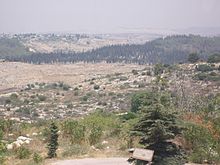- Desert farming
-
Desert farming generally relies on irrigation, as it is the easiest way to make a desert bloom. In California, the Imperial Valley is a good example of what can be done. Australia, Israel, and the Horn of Africa are also places with interesting desert agriculture.
One problem associated with raising traditional plants in a desert is depletion of the ground water. Drip irrigation is one way to reduce the overall water demand. Another is to grow crops that are acclimated to the desert, such as jojoba, Date palms, and citrus.
Native Americans of the Sonoran Desert have long practiced (and continue to practice) desert agriculture without irrigation. This is highly dependent upon both winter snow and rain and summer monsoonal weather patterns which move moist tropical air from the Gulf of Mexico into northern Mexico and the southwestern U.S. states of Arizona, Utah, New Mexico, and Colorado. This moist air, combined with the intense solar heating of the ground, can cause the development of substantial thunderstorms that can deluge some portions of the ground with great amounts of water over a short time. While the surface quickly becomes dry, and there is much runoff of the water into normally dry streams and riverbeds, a substantial portion is absorbed into the upper soil levels. To take advantage of this condition for agriculture it is essential that crops be started early in the season, where they utilize residual winter water from Pacific Ocean storms originating in the Gulf of Alaska and other Winter Pacific storms from the tropics (the "Pineapple Express"). The early sprouts from planted seeds (mostly beans, squash, and maize) are protected by starting them in small dug holes, where they are both closer to the winter water remaining in the soil and protected from the early spring frosts. Despite its success over a period of (likely) up to 14,000 years, there have been great difficulties with this form of agriculture since a drought beginning in 2002, with global warming suspected in changing weather patterns, and problems with ground water depletion due to extraction for modern conventional irrigated agriculture, metropolitan lawns, industrial purposes, and coal slurry pipelines (the latter now stopped through action by Navajo tribal authority).
The Native Americans practicing this agriculture included the ancient and no longer present Anasazi, the long-present Hopi, the Tewa, Zuni, and many other regional tribes, including the relatively recently arriving (about 1400 CE) Navajo. These various tribes were characterized generally by the Spanish occupiers of the region as Sinagua Indians, sinagua meaning "without water", although this term is not applied to the modern Native Americans of the region.
Owing to the great dependence upon weather, an element considered to be beyond human control, substantial religious beliefs, rites, and prayer evolved around the growing of crops, and in particular the growing of the four principal corn types of the region, characterized by their colors: red, yellow, blue, and white. The presence of corn as a spiritual symbol can often be seen in the hands of the "Yeh" spirit figures represented in Navajo rugs, in the rituals associated with the "Corn Maiden" and other kachinas of the Hopi, and in various fetish objects of tribes of the region.
American Indians in the Sonoran Desert and elsewhere relied both on irrigation and "Ak-Chin" farming—a type of farming that depended on "washes" (the seasonal flood plains by winter snows and summer rains). The Ak-Chin people employed this natural form of irrigation by planting downslope from a wash, allowing floodwaters to slide over their crops.
In the Salt River Valley, now characterized by Maricopa County, Arizona, a vast canal system that was created and maintined from about 600 AD to 1450 AD. Several hundred miles of canals fed crops of the area surrounding Phoenix, Tempe, Chandler and Mesa, Arizona. The ancient canals served as a model for modern irrigation engineers, with the earliest "modern" historic canals being formed largely by cleaning out the Hohokam canals or being laid out over the top of ancient canals. The ancient ruins and canals of the Hohokam Indians were a source of pride to the early settlers who envisioned their new agricultural society rising as the mythical phoenix bird from the ashes of Hohokam society, hence the name Phoenix, Arizona. The canal system is especially impressive because it was built without the use of metal implements or the wheel. It took remarkable knowledge of geography and hydrology for ancient engineers to lay out the canals, but it also took remarkable socio-political organization to plan workforce deployment, including meeting the physical needs of laborers and their families as well as maintaining and administering the water resources.
See also
Notes
External links and further reading
- P. Koohafkan and B.A. Stewart, Water and Cereals in Drylands published by The Food and Agriculture Organization of the United Nations and Earthscan
Categories:- Agriculture
- Agriculture by region
Wikimedia Foundation. 2010.

